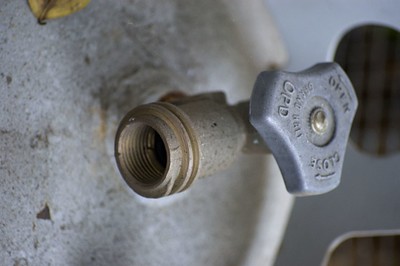
If you’re having trouble getting your propane tank to open, you’re not alone. Many people have trouble with this, and it can be frustrating. There are a few things that you can try, however, that may help you get the tank open. In this blog post, we’ll go over a few of the reasons why your propane tank may not be opening, and some tips on how to fix the problem.
But let us remind you about the safety precautions you can do when doing this: the clockwise direction is the way to turn the handwheel of the tank, if you’re doing it in the opposite direction, it tightens the wheel more securely making it difficult to open. If you turn the handwheel clockwise, and still it won’t loosen or turn, it may be jammed.
To loosen the wheel, a simple and DIY way is to put a small amount of oil in the handwheel let the oil sit for a while, and then try to turn the handwheel, it should loosen it. You can also use WD40, and spray a little on the handwheel, it will surely do the trick.
As safety advice, never use a hand tool when attempting to loosen a stuck valve/handwheel of the propane tank; too much pressure can damage it, resulting in a gas leak. If it is damaged, there’s no other choice – you need to replace it or buy a new one for your application.
Read related article: Before Exchanging, Ensure Tank Is Compatible With Appliance
What to do if you can still open it despite of the ways mentioned above
As a safety measure, before trying to open it, make sure the gauge is in the turn-off position so that the gas won’t flow with force and spatter on your face or open skin.
There are a few things you can try to get it to open the tank. Tap the valve with your hand lightly and try to slowly open if it doesn’t work, put downward pressure on the handwheel, and slowly turn it clockwise, I have done this many times with a tight valve, and it works most of the time.
To have a better grip when turning the valve, wrap a rubber or rug on the valve, this will give a good force to turn the valve clockwise. Be sure not to apply too much pressure, the last thing you don’t want to happen is breaking the threads inside.
If the tank still won’t open, you may need to bring it to a qualified technician; there could be damage to the threading of the valve. It needs to be replaced by a technician. The technician is a capable person to do it safely without damaging the tank.
Read related article: Difference Between a Propane Tank and a Propane Cylinder?
Uncommon Causes: Why Your Valve Might Not Open or Loosen
a. Pressure-Related Issues
Built-up backpressure and how it affects the valve operation:
Every propane tank is designed to handle a specific pressure level. When the internal pressure of the tank increases due to factors like overfilling or a blockage, it can lead to built-up back pressure. This excess pressure acts against the valve, making it challenging to open.
The role of ambient temperature in causing irregular pressure conditions inside the tank:
Propane tanks can be sensitive to external temperature changes. When exposed to extremely hot or cold temperatures, the gas inside the tank can either expand or contract, leading to variations in internal pressure. This can make it difficult to open the valve, especially in colder temperatures where the gas contracts, causing a vacuum effect.
b. Defective or Malfunctioning Excess Flow Valve (EFV)
Explanation of EFV and its function:
The EFV is a safety device within the propane tank designed to shut off or limit the flow of propane in the event of a major leak or rupture. It’s a critical component for preventing propane release during high-flow situations.
Symptoms of a malfunctioning EFV and how it prevents the main valve from operating:
If the EFV is defective or malfunctions, it might incorrectly detect a high flow rate and shut off the propane flow, even when the main valve is in the open position. Symptoms can include no gas flow despite an open valve and an unusually firm valve that doesn’t turn easily.
c. Dirt or Debris Build-Up
How tiny particles can cause the valve to jam or become hard to turn:
Over time, small particles, dirt, or debris can accumulate around the valve mechanism, especially if the propane tank is kept in dusty or dirty environments. These tiny obstructions can prevent the valve from turning smoothly or even jam it in place.
Preventative measures to avoid dirt and debris build-up:
Regularly clean the exterior of your propane tank and the valve area using a soft cloth. Ensure the tank is stored in a clean, dry area, and consider using a protective cover when the tank is not in use.
d. Imperfect Valve Alignment
Misalignment due to mishandling or accidental drops:
Dropping the tank or rough handling can cause the valve mechanism to become misaligned. This misalignment might make it difficult to turn the valve or even prevent it from opening altogether.
Tips to check and ensure proper alignment:
Visually inspect the valve for any signs of damage or misalignment. Handle propane tanks with care, and avoid dropping them or subjecting them to impacts. If you suspect misalignment, it’s best to consult a professional for repair or replacement.
e. Corrosion and Material Degradation
Exposure to harsh conditions leading to rust or corrosion:
Propane tanks exposed to wet or salty environments can experience rust or corrosion, especially around the valve area. Corroded parts can fuse together, making the valve hard to turn or open.
Identifying early signs and addressing them:
Regularly inspect your propane tank for signs of rust, discoloration, or any other forms of corrosion. If detected early, clean the affected area and protect it with appropriate rust-preventive measures. Store tanks in dry areas away from direct exposure to elements.
f. Over-tightening from Previous Use
Consequences of excessive force applied during closing:
Applying too much force when closing the valve can damage the internal mechanism or cause the threads to warp. This can result in the valve becoming challenging to reopen in the future.
Tips to avoid over-tightening:
Always turn the valve gently, ensuring you don’t apply excessive force. Familiarize yourself with the correct closing procedure and consider using a wrench or tool that provides adequate grip without promoting over-tightening.
Read related article: Which Propane Tanks Can Be Refilled (How to Identify)
You Can Buy These From Amazon
 |      |      |      |
How to troubleshoot a propane tank that will not loosen
There are a few reasons why a propane tank may not open. If the tank is new, it may be because the valve is not open all the way. Try opening the valve all the way and then trying to open the tank. If the tank is old, it may be because the valve is corroded. If the tank is very old, it may be because the valve is rusted. Try using WD-40 or another rust dissolver to try to loosen the valve.
How to prevent a tank from becoming stuck
Never leave the tank outdoors or in the rain, if the tank becomes rusted without you knowing it, the rust can penetrate inside the handwheel threading, making it difficult to turn or loosen the valve. This is a very common problem that can be avoided. When the tank is not in use, put the tank in a covered and safe area.
Excessive tightening also happens when the last person who used it turns the handwheel counterclockwise very hard. This can be difficult to loosen the valve. One thing you can do to loosen it is apply downward pressure while turning the valve clockwise.
When you are able to open it, do this for safety
If you were to open the handwheel of the tank but you applied a little force, there could be a minute leak that you won’t be able to notice. A leak like this is not only dangerous but the gas will run out so fast without you noticing it, you just find out why it runs out than usual.
In order to do a gas leak test, you can prepare soapy water, pour it on the valve, and put your one hand near the valve threading to settle the soap for a while. if you notice a bubble, then it is a telltale sign that the valve threading has been damaged causing the leak.
If this is the case, replace it by buying a brand-new one. Don’t opt to buy used tanks, these won’t last that long besides brand new ones just cost a little more to buy but you can be assured that it will last a long time.
Some safety precautions to take note of
If the tank is relatively old and still full, bring it to a professional to empty it and do the requalification of the tank. Tanks expire and they need to be requalified every 5 years. If the tank in question is too rusted and dented, it is better to put it into disposal. Disposing of such tanks will no longer pose a danger.
Never use a plier or wrench or other tool when trying to open the valve. If it is stuck and you are not able to do something, bring it to a gas dealer near you, and have the tank checked out by them because there could be other problems with the valve.
If you open the valve and the gas flows, don’t turn the handwheel all the way, it will release gas more than needed even if a regulator is connected.
Used propane tanks especially those repainted and old tend to have their valve stuck and won’t be able to turn or loosen.
Is the handwheel on your tank triangular shape?
The last question I leave here may be off-topic, but I want to ask it to you. If your tank’s handwheel is circular or star in shape, it doesn’t have OPD. Tanks like these are obsolete and need to be replaced. But it doesn’t mean it can be exchanged. Gas companies can accept it, when exchanging, they might exchange with an updated tank.
The updated and modern tanks are those with a triangular handwheel. These tanks have OPD and are required by industry regulation. It has been estimated that there are 40M-60M tanks without OPD still in circulation in the US market alone; imagine the staggering number of these tanks – this is the main reason why propane gas companies and suppliers still accepts those tanks without OPD.
Conclusion
Your propane tank is an essential component in many of your daily activities, whether it’s grilling up a feast or warming up your space. When you encounter a stubborn valve that won’t open or loosen, it’s natural to feel both inconvenienced and concerned.
By understanding the reasons behind these issues—be it safety mechanisms, obstructions, temperature fluctuations, or general wear—you’re better equipped to address the problem safely and effectively. Always prioritize your safety when troubleshooting.
Know when it’s time to take a step back and call in the professionals. With regular checks and proper maintenance, you can avoid many potential hiccups and ensure that your tank serves you well for years to come. After all, a little knowledge and proactive care can go a long way in ensuring both convenience and safety.


Mike is an experienced propane technician with over 15 years of professional experience in the field. He has dedicated his career to helping customers with their propane needs, from installation to maintenance and repair. Together with Jeremy, he co-founded this website to provide useful information and guidance to customers seeking reliable propane services.







